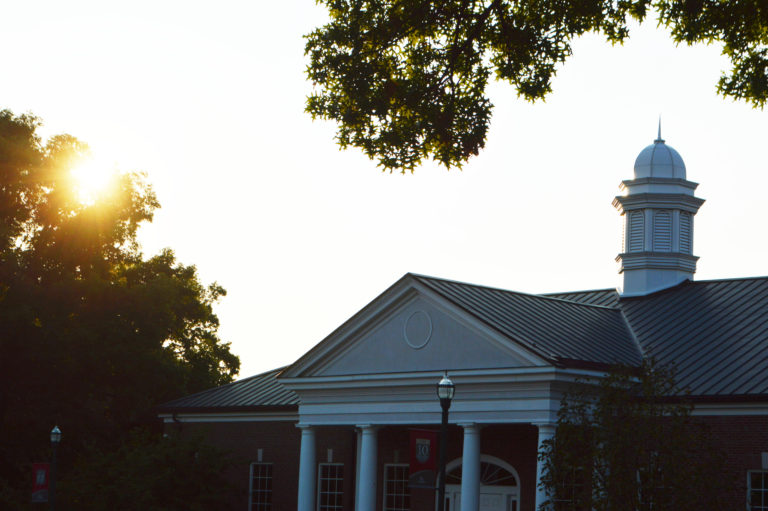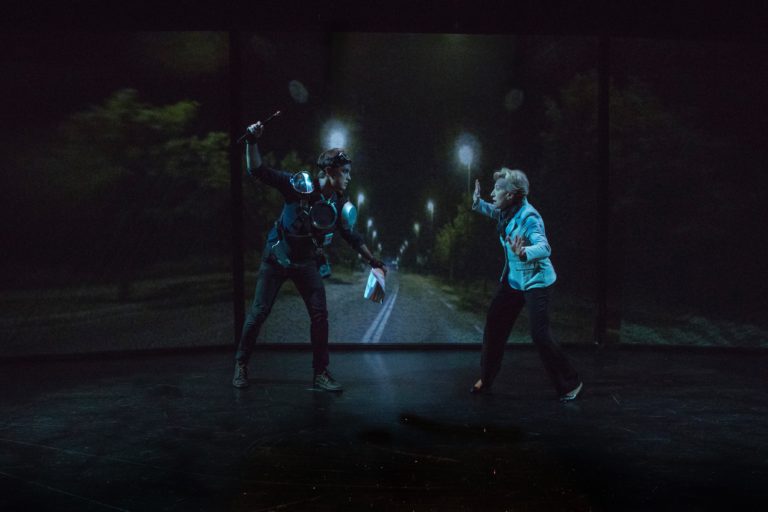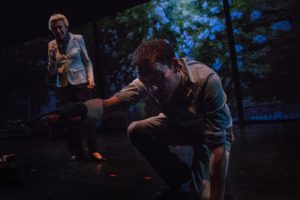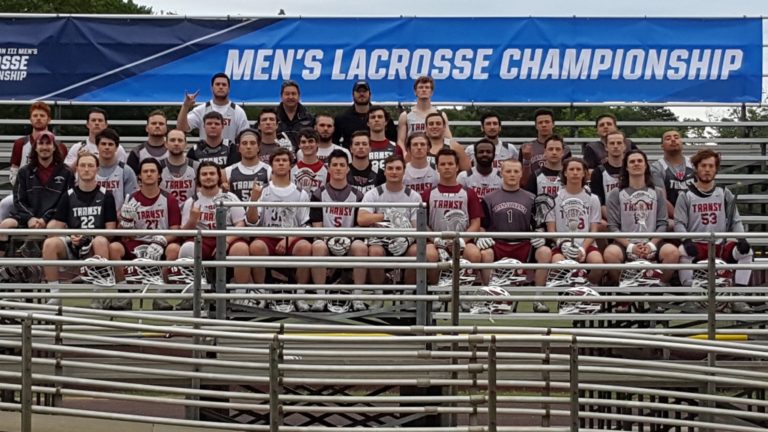Among the staffing changes within the university over the summer, one change in particular was noteworthy. Transylvania’s theater program experienced the loss of not one, not two, but three of its theater professors: Professor Sully White, Professor Michael Dixon, and Lecturer Michael Sanders. The professors’ last day was August 31st, 2017.
Melissa (Missy) Johnston has since taken over the position as Interim Director of Theater Activities. Johnston holds an MFA theater degree and over 30 years of experience as costume designer, set designer, actor, producer, and playwright, and has been working in the theater department at Transy since 2008. The Rambler reached out to former Professors Dixon, White, and Lecturer Sanders for comments, but only received a reply from Professor White, who did not give any clue as to why she or the others left. While the reason behind their sudden departures still remains unclear, The Rambler contacted students who were and currently are involved in some way with Transy’s theater program to ask what their thoughts were on the matter.
Did their decisions to leave come as a shock, or did something suggest their departure?
J.D. Lovell, sophomore. Theater and Accounting major: “It was a complete surprise, I was in disbelief when I found out. I spent a lot of time with those professors towards the end of May Term and they gave me no sign that they had intentions of resigning.”
Joseph Bahena, senior. Theater major: “I wasn’t shocked. I was shook. Like, come on! Have you ever heard of almost an entire department leaving at once!?”
Blake Taylor, senior: “No comment – what’s happened has happened and looking forward is really the only thing we can do to get the theatre education we provide to a respectable level.”
Trevor Kassis, junior. Philosophy major: “Something like this wasn’t outside of the realm of possibility in my mind, but it was a surprise nonetheless, especially so close to the beginning of the school year.”
Aaron Botts, senior. Theater and International Affairs major: “The news came as a shock. We all hated to see them go but whatever their motivations were for leaving we do know they did it for the best reasons. To my knowledge there were no signs showing that they were leaving immediately.”
What do you think this change means for the department itself?
Lovell: “I don’t think that anyone involved in the department are ones to lay down and quit when the going gets tough. I think we are all ready to do what it takes to continue making art.”
Kassis: “I was a theater minor, but this change led me to the decision to drop that minor, because I don’t want to subject myself to an anemic, stopgap program for two years. For majors, especially upperclassmen, this isn’t so much an option. I fear that the department will lose that feeling and become more geared toward simply getting the credits you need and moving on, at least during this transitional period.”
Bahena: “As a current theater major, I think this change means that we get to take what was given to us creatively and run with it.”
Taylor: “As a senior, who has had all of his required classes, and has been doing theatrical work outside of the university, the change doesn’t affect the nature of my goals on campus. For those that have many classes left to take, or had primary mentor-ship with the former professors I’m sure it is a bigger concern and issue considering our former professors were exceptional teachers and now we do not know who is being brought in.”
Ashleigh King, sophomore. History and Political Science major: “Of course the departure of the teachers will be a bit of a blow, but I don’t think that the theater department will go downhill. Especially because we have Missy (the interim director) to lead us. She’s amazing and so creative. Like the costumes she comes up with are just fantastic. We couldn’t have anyone better to lead us through this. But I’m confident that Transy will hire new staff that are just as talented and will bring their own personal flair to the department.”
Ben Wagner, Senior: “In terms of people who may want to pursue the major, do it! Missy Johnston is our interim department head and she’s been an amazing part of this department for almost a decade now. There’s no reason that this should scare anyone away from the theatre.”
Botts: “We aren’t losing the department or program, we are simply losing valuable friends, teachers, and mentors that have helped us better understand the subject. The good thing is we still have a department and I am confident Missy will keep the rigor and prestige Transylvania’s theatre is known for.”
What does this change mean for you, personally?
Bahena: “It means I’ve got to really start thinking of myself as an artist that takes creative leaps without a net to catch me if I fall. I’ve got to learn to be my own loving critic and my own motivator. I won’t be surrounded with a faculty that knows how to help me build upon my own artistic viewpoint by knowing me as well as they did. Ya know?”
Kassis: “For me, personally, it’s a major frustration. Theater is an expressive outlet that I truly love and want to engage with, and the Transy shows I’ve been a part of have been wonderful experiences. There were many courses I was excited to take and roles I wanted to try for that, now, I just won’t. Simply put, it sucks.”
Taylor: “It may have been revealed in the previous answer, but as it stood and still stands I’m not really emotionally tied to the program. With that being said, I think by starting fresh, we as a program, and as a university should look inward, criticize what was working/not working, have real honest conversation, and move forward to build a better future.”
Lovell: “I am very thankful for the opportunity I had to learn from them. I know that changes like this are not uncommon in a university. Therefore, I remain very positive about the department and I’m very excited for the upcoming year. Although I am very disappointed that their personalities and geniuses will not be on campus next year.”
Wagner: “Of course I’m sorry to see these three amazing people leave. I’ve become close with each of them since getting involved in the department and they’ve been something of mentors for me. But I also know that they’re going to continue doing amazing things and that this change is an incredibly hard decision that they’ve put so much time into making. “
Botts: “On a personal note, it is not like we have lost them forever. They are our friends and mentors and that relationship doesn’t stop just because they left the university.”
King: “Sully is an incredible director and mentor. She has such an eye for comedy and makes things funny so easily that it’s just astonishing. Sully just has this way of inspiring people to do better, which you can tell from the way that people talk about her. And that brings me to the wonderful Micheal Dixon. He directed my first play at Transy, Anonymous, which will always be such a special play. During Anonymous, he let us explore our own characters and make our own choices, a luxury that I wasn’t afforded in previous theater departments, and really helped me grow and dig about my acting style. I’ve never had a class with Mike Sanders but he is brilliant. I respect their decisions, but I will definitely miss all of them immensely.”
What do you think this major change in the department means for theater majors and people who want to pursue a major in theater at Transy?
Lovell: “We are obviously losing three great professors, three great professionals who are masters of their craft. The classes that I had the opportunity to take with them were some of the most effective that I took during my first year. Just in my first year at Transy I learned many things about myself as an actor, writer, and designer, thanks to them. So it will be a great loss in the classroom and in the creative process of each production. Ultimately though, with Missy Johnston as our interim director, the dedication of the students involved, and the resources we still have, I think Transy’s theatre department will continue to be very successful.”
Wagner: “It means that we’re losing people that have been core parts of our development and progress through the program. But, as it is in a lot of aspects of life, theatre is in a very constant state of flux, and so this is just a transition that will ultimately help us grow more. In terms of people who may want to pursue the major, do it! Missy Johnston is our interim department head and she’s been an amazing part of this department for almost a decade now. There’s no reason that this should scare anyone away from the theatre.”
Botts: “We will still have people who are interested in theatre and seek to study the subject. We aren’t losing the department or program, we are simply losing valuable friends, teachers, and mentors that have helped us better understand the subject. The good thing is we still have a department and I am confident Missy will keep the rigor and prestige Transylvania’s theatre is known for.”
King: “For anyone who wants to major in theater or even just be in one play in general, there are plenty of ways to be involved in theater without the actual theater department: Theater Guild, ImprompTU, and Bad Mouth Theater Company; all student run organizations that love new people to come and try out. All theater people are super welcoming and can always find a job for someone.”
Bahena: “I think if I were someone considering a theater major I would have to wait and see. When it comes down to how you handle your own educational experience, you should have a pretty good sense of who you are committing time and money into as a faculty. Especially when that faculty is supposed to be giving you a worthwhile advantage by attending Transy…or so the thought is. Only time can determine that.”
Kassis: “It’s safe to say that this is a huge disappointment to everyone involved in Transy theater. I and many others got involved with the program because of the exceptional team of artists Transy had on staff, and to see them go, especially for those of us who have already seen and experienced what they can do, is quite a blow. Administration has assured theater majors that they will be able to graduate on time, but for a lot of them, that’s not what it was all about. They wanted to experience what theater could really be in an academic environment, to cultivate their own artistry under the instruction of proven professionals. I fear that the department will lose that feeling and become more geared toward simply getting the credits you need and moving on, at least during this transitional period.”
Taylor: “I think there are different responses when looking at current majors vs. perspective students. For current majors, I think that if you really want to pursue the art form, than that is what you must do, continually pursue the art form. It’s kind too late for some of us to quit now. Does that have to be represented by the major you choose, or whether or not you do your work on campus, based on who is teaching the classes, and directing the shows moving forward? That’s a question I can’t answer for anyone, but myself. For those who want to pursue a major in theatre at Transy, I firmly believe that until the university hires a set of professors who are committed to bring optimism and a sense of commitment and growth to the university, that students should seek their education elsewhere. Why ask a student to spend their money and time at university whose program is unstable and unreliable at the moment? You come in expecting something from what you were shown, and the check you are writing to the university. To have that stripped away definitely deserves o conversation and demands from the students.”
Do you think the change in the theater department will cause students interested in theater to leave?
Lovell: “We are actors, designers, and writers. We are adaptable. We are given our instructions and we find a way to make it work. We still have a strong department with a wonderful director. I think we are all ready to do what it takes to continue making art.”
Bahena: “I think it all depends on who is hired. That sorta determines what shows are produced, what opportunities are offered, how inclusive we are, what the culture of the whole program is, etc.”
King: “The good thing about our theater department is that everyone is extremely dedicated. So those who are in multiple plays usually don’t stop, if their schedules allow it. So I doubt that people will leave because theater is just too much fun. I’m not sure if it’ll grow, because you can never tell about these kinda things, but I sure do hope more people will try out theater and see if they like acting on stage. Truthfully, I think it’s an experience everyone needs; the discipline, the people, and the magic. It’s just too special to pass up.”
Kassis: “I hope that those interested in theater will be able to turn that energy toward Transy’s Theater Guild. The Guild has been growing in great ways over the past few years, and, although the mentors that helped it achieve this growth are gone, I hope that it won’t lose the momentum it has accumulated.”
Botts: “Honestly, I’m not sure. I came in as a theatre major and might not have come here if a program or scholarship didn’t exist. If the university decides to cut the program (the theatre major and scholarship) altogether it would be as a detriment to the liberal arts education. I earnestly hope they don’t cut the program because we’ve gotten to work alongside awesome people and make some beautiful art. We still have Missy and she’ll still teach students theatre so all is not lost.”
Wagner: “I really hope that no one is going to feel pushed out by the change. The people that I get to work with every day via the program are ones that work longer hours than you would imagine doing physically and mentally demanding work, so in my mind no one is apt to lay by the wayside or panic as this new wave comes in. Of course, things will be changing, as they do when such a shift happens, but I don’t believe that’s much of a cause for worry and I hope that the other students in the department will see it the same way. The shift very well may attract new people to join and test the waters, which would be phenomenal! It’s always fun to see new people come out and try their hand.”
Taylor: “There are many universities that have excellent faculty, have administrations, and student bodies that really support the arts. In order for that to happen the university would genuinely need to listen to the wants and needs of the current students, and they would need to have real commitment in supporting and encouraging new committed faculty. Bringing in adjuncts for me isn’t enough to create something sustainable. Our education in our desired major is just as important to us, and the world, as the education and work of someone in a more mainstream major. Until that is understood, and implemented through a real desire to build a positive and growing program by students and admin, seek elsewhere.”
In an email sent to all theater majors and minors, the university assured current students that the university has made suitable arrangements to cover all classes needed to complete their already-undertaken majors. The long-term future of the theater program was not discussed.











 Tristan Reynolds (Editor-in-Chief): The Kentucky Theater is a really excellent place to see independent movies (if you’re a snobby cinéaste like I am). It’s pretty quiet for most showings, so you don’t have to worry about rude interruptions from groups of teenagers who insist that their phones are more interesting than the movie. They also host plenty of local film festivals, and regular screenings of movies like Rocky Horror that encourage audience engagement and a fun atmosphere. It’s pretty cool stuff.
Tristan Reynolds (Editor-in-Chief): The Kentucky Theater is a really excellent place to see independent movies (if you’re a snobby cinéaste like I am). It’s pretty quiet for most showings, so you don’t have to worry about rude interruptions from groups of teenagers who insist that their phones are more interesting than the movie. They also host plenty of local film festivals, and regular screenings of movies like Rocky Horror that encourage audience engagement and a fun atmosphere. It’s pretty cool stuff. Aaron Martin (Managing Editor): Doodles is one of my favorite local restaurants. Since it’s open every day except Monday, it can be a nice place to go to in the mornings before class to get some extra studying in. During nice weather, they have the option to sit outside and eat which is refreshing and something I especially love. The staff there is so welcoming and kind and if you go there enough (or in my case, too much) they actually remember your face and your order which is kind of rare to find in a city. They now offer discounts to any Transy student on any day so that, of course, is always an added bonus. Overall, the environment is just really nice and soothing and a place I would definitely recommend. (P.S. make sure to order some beignets!)
Aaron Martin (Managing Editor): Doodles is one of my favorite local restaurants. Since it’s open every day except Monday, it can be a nice place to go to in the mornings before class to get some extra studying in. During nice weather, they have the option to sit outside and eat which is refreshing and something I especially love. The staff there is so welcoming and kind and if you go there enough (or in my case, too much) they actually remember your face and your order which is kind of rare to find in a city. They now offer discounts to any Transy student on any day so that, of course, is always an added bonus. Overall, the environment is just really nice and soothing and a place I would definitely recommend. (P.S. make sure to order some beignets!)
 Taylor Mahlinger (A&E Editor): Vinaigrette for food and Daily Offerings Coffee Roastery for the best coffee ever!!! (plus it’s organic and very hipster).
Taylor Mahlinger (A&E Editor): Vinaigrette for food and Daily Offerings Coffee Roastery for the best coffee ever!!! (plus it’s organic and very hipster). Megan Schandel (Commentary Editor): For those willing to walk a little further from campus, Wild Fig Books & Coffee is an excellent place to grab a cup of coffee or a bite to eat and find a new book to read. Located in a historic house on North Limestone, Wild Fig hosts open mic nights and several reading events throughout the year. This family-owned business is a hidden gem worth visiting. Located on 726 N Limestone.
Megan Schandel (Commentary Editor): For those willing to walk a little further from campus, Wild Fig Books & Coffee is an excellent place to grab a cup of coffee or a bite to eat and find a new book to read. Located in a historic house on North Limestone, Wild Fig hosts open mic nights and several reading events throughout the year. This family-owned business is a hidden gem worth visiting. Located on 726 N Limestone.


